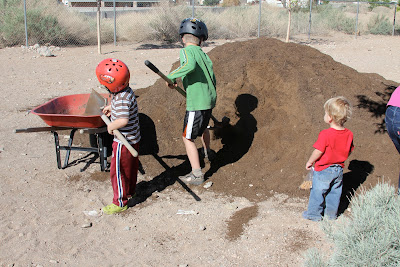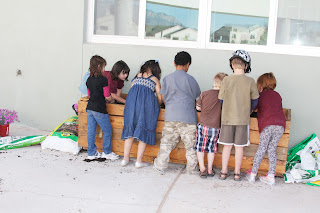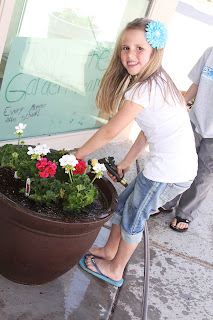1. Make sure soil in garden box is moist.
2. Very gently pull seedling out of plug tray by holding the plug upside-down and pushing it out from the bottom. Be careful.
3. Dig hole to fit seedling roots in...if seedling is scraggly (stem is elongated) plant stem all the way in soil up to -1/2"-1" away from first or second set of leaves.
5. Fill hole with soil.
6. Water.
7. Talk with your GARDEN BOX PARTNER and work out a schedule for watering. It is vital that the plants are watered three times a week, because of the dry, arid climate here in NM.
8. Check the soil everyday to see if it is moist. If it is bone-dry, the plants are thirsty and will not survive.
9. We are hoping that in the summer that UNM volunteers will be willing to come water as well as the summer school classes, etc. that will be held at MMES over the summer. We are still in the process of coordinating these details.
For example
Week 1: Teacher A waters on Monday and Friday.
Teacher B waters on Wednesday.
Week 2: Teacher A waters on Wednesday.
Teacher B waters on Monday and Friday.
Below is more specific information on how to transplant seedlings.
Transplanting
seedlings into the ground
Harden off vegetable seedlings that have been
grown indoors or purchased from a greenhouse before exposing them to the
elements. Hardening off is a way of increasing your plant's stamina before
planting — similar to slowly acquiring a base tan before taking that outdoor,
tropical vacation. Plants that have been growing outside at the nursery can go
right into the ground, but greenhouse-grown plants are lush and soft and have
never known a single day of sunshine in their lifetimes. You have to introduce
them slowly to the harsh, real world.
To harden-off seedlings, leave the plants in their
containers and put them in a shaded area with some indirect light for a few
days. A north-facing, covered porch is ideal. Whenever a freeze is predicted,
bring the plants inside overnight. If these are shade plants, you can leave
them in this protected site for a few more days and then put them in the garden.
For sunny-spot plants, give them a few days in the shaded area and then place
the plants in a sunny location for an hour one day. Give them a couple of hours
of sun the next day, and so on, increasing their exposure each day. At the end
of a week, the plants are thoroughly accustomed to sunlight and wind and are
ready to go into their new home.
Don't overharden your plants. Certain crops, such as
cabbage and broccoli, can bolt (flower before they're supposed to)
quickly if seedlings over three weeks old are repeatedly exposed to
temperatures lower than 40°F (4°C) for a couple of weeks.
Before transplanting your seedlings, you need to prepare
your soil and sculpt beds or rows, and your garden must be ready to plant. When setting out plants in biodegradable peat pots,
make slits down the sides of the pots or gently tear the sides to enable the
roots to push through. Also, tear off the lip (top) of the pot, so that it
doesn't stick up above the soil surface and pull moisture out of the soil. With
premade growing blocks encased in netting, cut off the netting before planting.
Choose a calm, cloudy day to transplant, if possible. Late
afternoon is a good time because plants can recover from the shock of
transplanting without sitting in the midday heat and sun. If you don't get an
ideal transplanting day and the weather is hot and sunny, shade the plants
until the sun goes down. Don't be alarmed if your plants look a little droopy
after you set them out because they'll soon recover. Cabbage seedlings can
droop and look almost dead, for example, and then be up and growing in a day or
two.
Sowing
seeds directly in your garden
Unless you live in an area where summers are really short,
you're better off sowing some types of vegetables directly in a garden.
Large-seeded, fast-growing vegetables, such as corn, melons, squash, beans, and
peas, usually languish if they're grown in containers for even a day or two too
long.
Before direct seeding, make sure that the soil has dried
out sufficiently before you work it, and be sure that the soil is warm enough
for the seeds that you want to plant. Pea seeds, for example, germinate in soil
as cool as 40°F (4°C), and you can plant them as soon as you can work the soil
in spring. Squash seeds, on the other hand, need warmth. If your soil temperature
is much below 65°F (18°C), the seeds are likely to rot in the ground before
they sprout. The best way to determine the temperature of your soil is to use a
soil thermometer, which you can buy at a garden store.
You can plant seeds in a variety of patterns. The method
that you choose depends on your climate, your tools, and your taste:
·
Row
planting: Mark the placement of a row within your
garden, and then make a furrow at the correct depth along the row. Some seeds
may not sprout, so sow seeds more thickly than you want the final spacing of
the crops to be. Thinning rows is less of a chore if you space
seeds as evenly as possible. Cover the seeds with fine soil and then firm them
in with the back of a hoe to make sure that all the seeds are in contact with
the soil. Water gently. If you plan to use furrow irrigation, fill the furrows
with water first and then push the large seeds into the top of raised beds.
·
Wide
row planting: This method allows you to plant more
seeds in less space by concentrating watering, weeding, and fertilizing in a
smaller area. Rows are generally 10 to 16 inches (25 to 41 cm) wide. Sprinkle
seeds over the entire row — with most crops, try to land the seeds about 1/2 to
1 inch (1 to 2 cm) apart. For peas and beans, space them 1-1/2 to 2 inches (4
to 5 cm). Cover small seeds with a thin layer of potting soil. Lightly pat the
potting soil down again to bring the added soil into firm contact with the
seeds.
·
Bed
planting: Planting in beds is essentially the same as planting wide rows.
·
Hill
planting: Plant seeds for vining crops that spread out, such as squash,
melons, or cucumbers, in hills or circular groups. Loosen the soil in a
1-foot-diameter (30 cm) area, level the area, and then plant five to six seeds
close together. Thin out all but the two strongest seedlings.
If your soil is heavy, you may want to plant in a raised
hill, or mound. The raised soil warms up more quickly than the surrounding soil
and drains better. Just don't let the mound dry out!
Soon after seedlings grow their second set of true leaves, you need to thin them out to avoid
overcrowding. (The first set of leaves that a seedling produces are called seed leaves or cotyledon,which are followed by the true leaves.)
When you thin plants, either discard the extra seedlings or move them to
another part of your garden.
Newly transplanted seedlings need extra attention until
they get established. Shade them from the hot sun for a day or two and be sure
to keep them well watered.
http://www.dummies.com/how-to/content/planting-vegetables-from-seed-and-seedling.html



































































